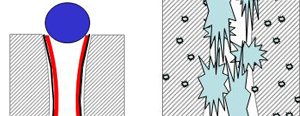Most concrete structures are designed such that the water is intended to stay put – either on the inside, like with a reservoir, or on the outside, as with a basement. Similar to a sponge, concrete is porous and cannot stop water from moving through it. The water travels through the capillary pores, cracks and joints that naturally exist in all concrete.
So what waterproofing options are best for your structure? There are a number of waterproofing options out there, each with their own unique properties. Integral concrete waterproofing technologies can be classified into two very distinct types: hydrophobic (water-hating) and hydrophilic (water-loving).
Hydrophobic Materials
 Mostly surface-applied, hydrophobic solutions are mainly surface coatings with little penetration capabilities. Water absorption is effectively reduced by promoting a beading effect. However, they are ineffective under pressure, as the pores remain open and water can still be forced in. They also eventually require re-application, as the surface product will wear away over time.
Mostly surface-applied, hydrophobic solutions are mainly surface coatings with little penetration capabilities. Water absorption is effectively reduced by promoting a beading effect. However, they are ineffective under pressure, as the pores remain open and water can still be forced in. They also eventually require re-application, as the surface product will wear away over time.
Example: Hydrostop Sealer
Where you would use it?
Use to treat any masonry surface made from concrete, brick, mortar, grout, tile, terra-cotta, plaster, stone, and limestone.
Hydrophilic Technology
 In contrast, hydrophilic technology actually uses water and turns it into microscopic crystals using a chemical reaction. The crystals increase in number and length to densify and seal concrete pores and voids. The components of such a reaction are mobile and can be carried wherever water will take them, which effectively grows more crystals until such water pathways are completely blocked. The resulting crystal product is integrally bound with the concrete for the duration of the life of the structure. Reactions can continue in the presence of new moisture to aid in self-sealing.
In contrast, hydrophilic technology actually uses water and turns it into microscopic crystals using a chemical reaction. The crystals increase in number and length to densify and seal concrete pores and voids. The components of such a reaction are mobile and can be carried wherever water will take them, which effectively grows more crystals until such water pathways are completely blocked. The resulting crystal product is integrally bound with the concrete for the duration of the life of the structure. Reactions can continue in the presence of new moisture to aid in self-sealing.
Example: Krystol Internal Membrane; Krystol T1 & T2
Where you would use it?
Use for all new concrete that will be subject to water pressure and can be used in precast, cast-in-place and shotcrete applications.
May also be used as a brush on application for existing concrete structures, such as foundations and walls, elevated slabs and ramps, parking structures, water towers and bridge decks






